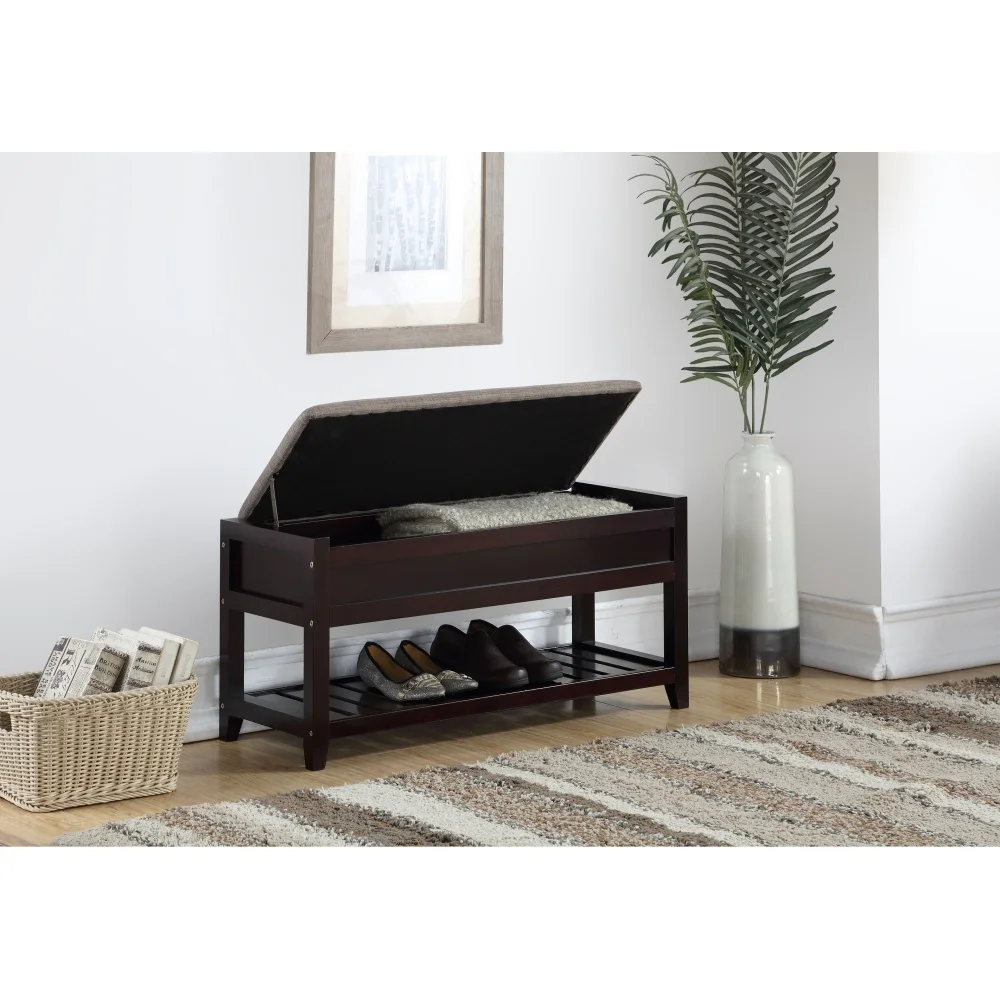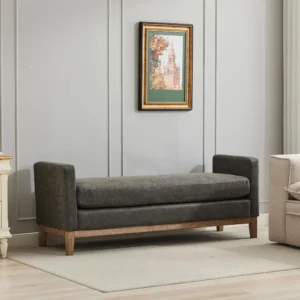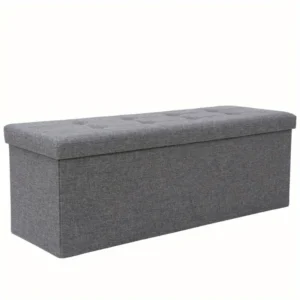Understanding the Benefits of a Shoe Storage Bench
A shoe storage bench combines two essential functions into one piece of furniture: a comfortable place to sit and a practical solution for organizing footwear. This dual-purpose design makes it an ideal addition to many homes, especially those where space is at a premium.
The advantages of these versatile pieces extend far beyond their obvious functions:
- They maximize limited space by combining seating and storage in a single footprint
- They create organization in high-traffic areas like entryways, where shoes tend to accumulate
- They significantly reduce visual clutter, instantly making your home feel more organized
- They offer convenient seating for putting on or removing shoes, particularly helpful for children and older adults
- They enhance your home’s décor while solving a common organizational challenge
Consider that the average person owns multiple pairs of shoes, with households often accumulating dozens of pairs collectively. Without proper storage, these shoes become scattered obstacles throughout your entryway. A well-designed entryway furniture with shoe compartments transforms this chaos into an orderly, welcoming entrance to your home.
Many homeowners find that investing in quality shoe storage benches dramatically improves both the functionality and appearance of their entryways.
Essential Considerations Before Purchasing
Before selecting the perfect shoe storage bench, take time to assess your specific needs and circumstances to ensure you make the right choice.
Household Size and Storage Requirements
Consider how many people will be using the bench for shoe storage. A family of four typically needs space for at least 8-12 pairs of everyday shoes, while a single person or couple might need considerably less. Think about your household’s shoe habits – do you have a large collection, or just a few essential pairs?
Footwear Types and Sizes
The types of shoes you’ll be storing significantly impact which bench design will work best. If you need to accommodate tall boots, look for benches with adjustable shelving or dedicated boot storage. Athletic shoes, dress shoes, and children’s footwear each have different space requirements.
Available Space Dimensions
Take careful measurements of your intended location. Standard entryways in apartments may only accommodate benches up to 36 inches wide, while larger homes might have space for 48-inch or longer options. Height and depth are equally important – you’ll need about 16-20 inches of depth for most shoe storage benches.
Accessibility Needs
Consider who will be using the bench. If children need to access their shoes independently, look for open storage at a lower height. For elderly users, prioritize sturdy construction with a comfortable seating height (typically 17-19 inches).
Understanding the comprehensive ultimate guide to shoe storage benches can help you identify which features matter most for your situation.
Measuring Your Space Correctly
Proper measurements are crucial to finding a bench that fits perfectly in your intended location. Taking the time to measure accurately will save you from the disappointment of receiving a piece that’s too large or too small.
Here’s how to measure effectively:
- Width: Measure the wall space or area where the bench will sit
- Height: Consider ceiling height only if restricted (like under stairs)
- Depth: Measure from the wall outward, considering traffic flow
- Clearance: Allow at least 24-36 inches in front of the bench for comfortable seating and accessing shoes
Standard shoe storage bench dimensions typically fall within these ranges:
– Width: 36-48 inches (91-122 cm)
– Depth: 16-20 inches (40-51 cm)
– Height: 18-20 inches (46-51 cm)
For particularly narrow hallways or small apartments, you may need to explore specialized perfect bench options for tight hallways. In extremely limited spaces, consider narrow entryway bench options that prioritize depth efficiency without sacrificing functionality.
Remember to account for any architectural features like baseboards, which may affect how flush your bench can sit against the wall.
Types of Shoe Storage Benches
Shoe storage benches come in several distinct designs, each offering unique advantages depending on your preferences and needs.
Open Storage Designs
Open storage benches feature exposed shelves, cubbies, or racks beneath the seating surface.
Advantages:
– Provides easy visibility and accessibility to all shoes
– Offers superior ventilation, allowing shoes to dry naturally
– Creates a more casual, relaxed appearance
– Makes it easy to see if shoes are missing
Considerations:
– Shoes remain visible, which may create a busier appearance
– Requires more regular organization to maintain a tidy look
– Offers less protection from dust
Open shelving works particularly well for active households where shoes are frequently changed and need to dry quickly. The entryway bench shelf storage options provide excellent organization while maintaining visual access to all items.
Closed Storage Options
Closed storage benches conceal shoes behind cabinet doors, inside drawers, or under lift-top seating.
Advantages:
– Creates a cleaner, more minimalist appearance
– Protects shoes from dust accumulation
– Hides visual clutter instantly
– Often provides more versatile storage options
Considerations:
– Reduced ventilation may affect shoes that are put away damp
– Requires opening doors or lifting tops to access shoes
– May have slightly less accessible storage
Closed storage benches are ideal for formal entryways or when you prefer a more polished look. They’re excellent for hiding seasonal footwear or less frequently worn shoes.
Hybrid/Combination Designs
Many modern designs combine elements of both open and closed storage for maximum versatility.
Advantages:
– Balances visibility with concealment options
– Allows organization by frequency of use or by family member
– Provides specialized storage solutions for different shoe types
The shoe cubby bench represents a popular hybrid approach, featuring individual compartments that keep shoes separated while remaining somewhat visible and well-ventilated.
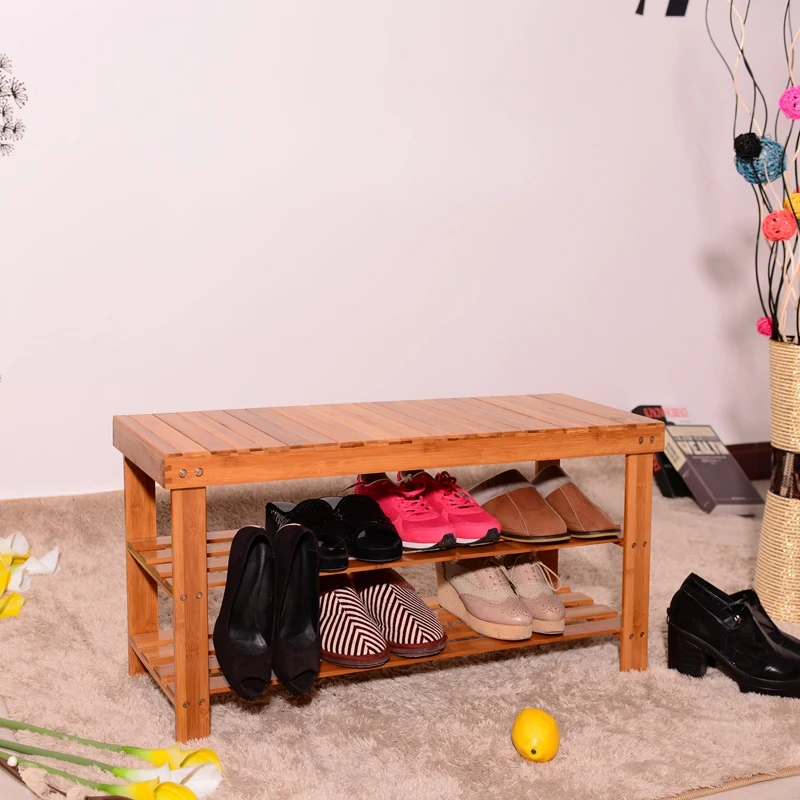
Material Options and Durability Factors
The materials used in a shoe storage bench directly impact its durability, appearance, and maintenance requirements. Understanding these differences will help you select a bench that withstands daily use while complementing your home.
Wood Construction
Wood remains the most popular material for shoe storage benches, offering classic appeal and proven durability.
Solid Wood:
– Provides exceptional sturdiness and longevity
– Develops character over time with a natural patina
– Resists warping when properly constructed
– Typically carries a higher price point
– May require occasional refinishing to maintain appearance
Engineered Wood (MDF, Particleboard with Veneer):
– Offers good durability at a lower price point
– Provides consistent appearance without wood grain variations
– May be more vulnerable to moisture damage
– Can be equally attractive with quality veneers
The wood entryway bench options from Nested Goods showcase how different wood finishes can complement various home styles, from rich walnut to lighter oak tones.
Metal Elements
Metal components add structural integrity and style to many bench designs.
- Steel frames provide exceptional weight capacity
- Wrought iron details add decorative elements
- Metal mesh or slat designs offer excellent ventilation
- Typically requires minimal maintenance
- May feel colder or less comfortable for seating without cushioning
Upholstered Features
Many benches incorporate fabric or upholstered elements for comfort and style.
- Provides comfortable seating for longer periods
- Adds softness and texture to entryway design
- Available in countless colors and patterns
- May require more frequent cleaning, especially in high-traffic areas
- Look for performance fabrics if durability is a concern
When selecting materials, consider the bench’s location and expected usage level. Entryways exposed to outdoor elements may require more weather-resistant materials, while indoor locations allow for more delicate options.
Key Features That Enhance Functionality
Beyond basic design and materials, specific features can significantly improve a shoe storage bench’s utility and convenience.
Storage Capacity and Configuration
- Most standard benches accommodate 6-12 pairs of adult shoes
- Adjustable shelving allows customization for different shoe heights
- Dedicated boot storage sections accommodate taller footwear
- Consider how the storage is divided (individual cubbies vs. open shelves)
Seating Comfort and Stability
- Weight capacity typically ranges from 250-450 pounds
- Bench height between 17-20 inches provides ideal sitting ergonomics
- Cushioned seating adds comfort but requires occasional cleaning
- Broader seating surfaces accommodate multiple people simultaneously
Ventilation Considerations
- Slatted shelving promotes air circulation
- Wire mesh components prevent moisture buildup
- Some designs include discreet ventilation holes in closed storage areas
- Proper ventilation prevents odor development and extends shoe life
Additional Storage Features
Many benches incorporate extra functionality beyond basic shoe storage:
- Hidden compartments for small items like keys and gloves
- Entryway bench drawers for storing seasonal items or cleaning supplies
- Overhead coat hooks or full hall tree integration
- Lift-top seating that reveals larger storage compartments
Assembly Requirements
Consider the complexity of assembly before purchasing:
– Some benches require significant assembly time (1-3 hours)
– Higher-end options often arrive mostly assembled
– Check if specialized tools are required
– Assembly difficulty may correlate with overall stability
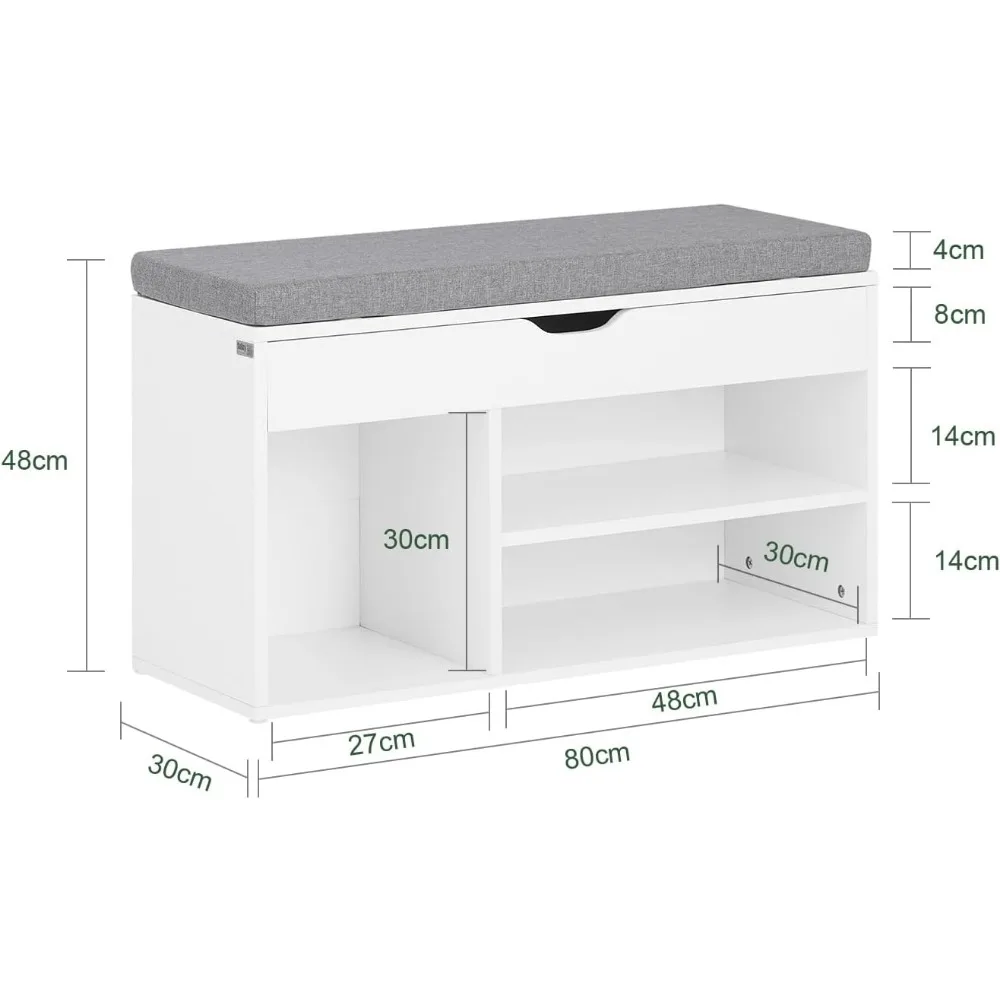
Style and Design Considerations
A shoe storage bench isn’t just a functional piece—it’s often one of the first furniture items people see when entering your home. Selecting a style that complements your existing décor creates a cohesive, welcoming impression.
Popular Style Categories
Modern/Contemporary:
Modern entryway bench designs feature clean lines, minimal ornamentation, and often incorporate materials like metal, glass, and engineered wood. These pieces work well in contemporary homes with open floor plans and minimalist aesthetics.
Traditional:
Traditional benches offer classic details, turned legs, and often feature rich wood tones or painted finishes. These pieces complement homes with traditional architecture and furnishings.
Farmhouse/Rustic:
The popular farmhouse entryway bench style features distressed finishes, natural wood textures, and a more casual, lived-in appearance. These benches add warmth and character to any entry.
Industrial:
Industrial designs combine metal frameworks with wood elements, often featuring exposed hardware and structural components. These pieces work well in urban lofts and modern spaces with raw architectural elements.
Color and Finish Considerations
- Lighter finishes visually expand small spaces but may show dirt more readily
- Darker tones add sophistication but may make tight spaces feel smaller
- Natural wood finishes provide timeless appeal and hide minor scratches
- Bold colors can make a design statement but may limit future décor changes
- Consider how the bench color coordinates with flooring and wall colors
Design Versatility
The most successful shoe storage benches balance distinct style with design versatility. Look for pieces with:
– Timeless proportions that won’t quickly look dated
– Neutral elements that can adapt to evolving décor preferences
– Quality construction that maintains appearance through years of use
– Details that complement rather than compete with other furnishings
Entryway Bench with Cushion, Mudroom Bench with Cushion, Shoe Bench for Entryway
$1,186.63 Select options This product has multiple variants. The options may be chosen on the product pageCoat Rack Shoe Bench, Corner Entryway Bench, Corner Hall Tree, Shoe Bench for Entryway
$313.58 Select options This product has multiple variants. The options may be chosen on the product pageEntryway Bench with Back, Modern Entryway Bench, Shoe Bench for Entryway
Price range: $463.13 through $474.44 Select options This product has multiple variants. The options may be chosen on the product pageShoe Storage Bench for Entryway
$459.02 Select options This product has multiple variants. The options may be chosen on the product pageEntryway Bench with Shelf Storage, Shoe Bench for Entryway, Shoe Storage Bench
$194.08 Select options This product has multiple variants. The options may be chosen on the product pageCorner Entryway Bench, Entryway Bench with Cushion, Modern Entryway Bench, Shoe Bench for Entryway
$476.34 Select options This product has multiple variants. The options may be chosen on the product page
Optimal Placement Strategies
Where you position your shoe storage bench significantly impacts both its functionality and how it contributes to your home’s overall design. Consider these placement options for maximum benefit.
Entryway Placement
The most traditional location, entryway placement offers immediate convenience:
– Positions seating exactly where it’s needed for shoe changes
– Creates a natural “drop zone” for just-removed footwear
– Establishes a transition point between outdoors and indoors
– Often works well against walls to maximize traffic flow
For comprehensive organization, explore the ultimate guide to organizing shoes in the entryway for additional strategies that complement your bench placement.
Mudroom Integration
Mudrooms provide ideal locations for shoe storage benches:
– Offers more space than typical entryways
– Contains mess from outdoor shoes in a dedicated area
– Allows for larger bench sizes with expanded storage
– Creates a functional transition space for active families
Bedroom Applications
Bedroom placement works particularly well for:
– Storing dress shoes and special occasion footwear
– Creating end-of-bed seating with hidden storage
– Organizing personal shoe collections
– Keeping specific shoes separate from the household collection
Creative Placement Solutions
Beyond conventional locations, consider:
– Under stairwells to maximize otherwise unused space
– In hallway nooks to create functional rest points
– At the edge of living areas for overflow seating with hidden storage
– In children’s rooms for toy storage and shoe organization
For optimal placement, ensure:
– At least 36 inches of clearance in front of the bench
– Adequate lighting for seeing shoe details
– Proximity to where shoes are removed or needed
– Sensible traffic flow around the piece
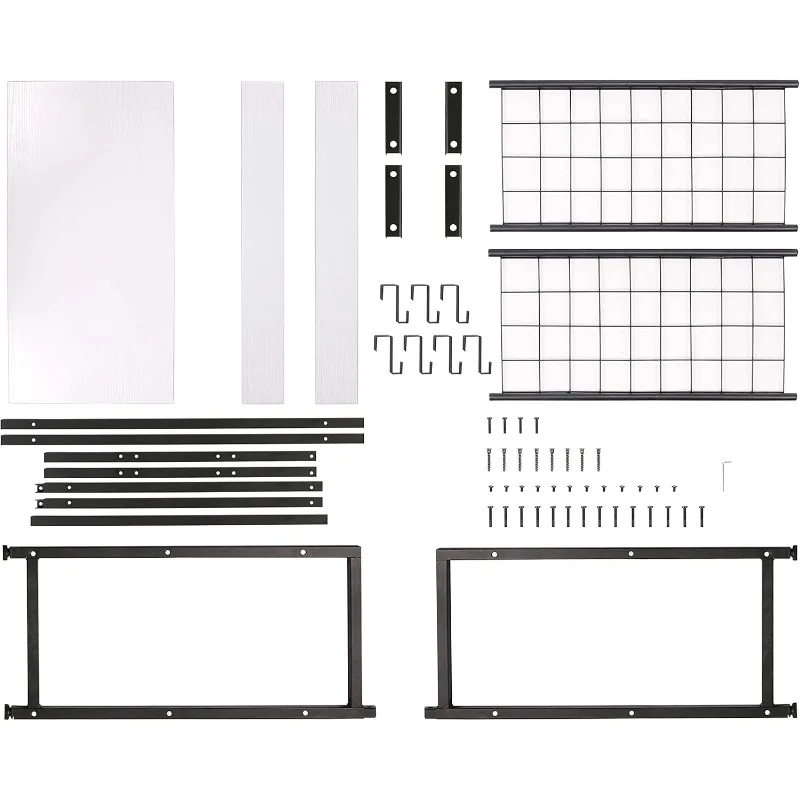
Budget Considerations and Value Assessment
Shoe storage benches span a wide price range, making it important to understand what drives cost differences and where to invest for lasting value.
Price Range Expectations
Entry-level benches typically start around $100-$150, offering basic functionality with engineered wood construction and simpler designs. These may work well for temporary solutions or light use areas.
Mid-range options ($200-$400) represent the sweet spot for most consumers, offering solid construction, better materials, and more refined design elements. At this price point, expect good durability and aesthetic appeal.
Premium benches ($450+) feature superior materials like solid hardwoods, high-end upholstery, specialized storage configurations, and distinctive design elements. These investment pieces typically offer the best longevity.
Understanding the factors behind mud bench costs can help you make informed decisions about where to allocate your budget.
Value Indicators
When assessing value, look beyond the price tag to evaluate:
- Construction methods (dowel joints and screws offer better durability than staples)
- Material quality (solid wood components in high-stress areas)
- Weight capacity specifications (higher limits typically indicate stronger construction)
- Warranty coverage and duration
- Customer reviews focusing on long-term performance
- Brand reputation for quality and customer service
Investment Priorities
Allocate your budget toward features that matter most for your situation:
- Prioritize sturdy construction for high-traffic areas
- Invest in quality upholstery if comfort is important
- Consider higher-capacity storage for larger households
- Look for adjustable components if versatility matters
- Don’t overspend on decorative elements if functionality is your primary concern
Remember that the true value extends beyond the initial price—a well-made bench will serve your family for many years, making even premium options cost-effective over time.
Maintenance and Care Guidelines
Proper maintenance ensures your shoe storage bench remains functional and attractive for years to come. Follow these material-specific guidelines for best results:
Wood Care Tips
- Dust regularly with a soft, slightly damp cloth
- Clean spills immediately to prevent staining
- Apply furniture polish or wood conditioner every 3-6 months
- Avoid placing in direct sunlight which can cause fading
- Use coasters under items to prevent water rings
Upholstery Maintenance
- Vacuum fabric surfaces weekly using upholstery attachment
- Treat spills immediately with appropriate cleaners
- Consider fabric protectant sprays for prevention
- Follow manufacturer cleaning codes (S=solvent, W=water-based)
- Rotate cushions regularly if removable
Metal Component Care
- Wipe with damp cloth and mild detergent as needed
- Check and tighten any loose screws quarterly
- Apply touch-up paint to scratched areas to prevent rusting
- Use metal polish on exposed decorative elements
Odor Prevention
- Place cedar blocks or activated charcoal bags in storage compartments
- Ensure shoes are dry before storing
- Leave cabinet doors open occasionally for ventilation
- Consider shoe deodorizing products for high-use benches
Preventive Maintenance
- Inspect joints and stress points quarterly
- Re-tighten hardware as needed
- Address scratches or damage promptly
- Keep bench away from heating vents and radiators
With proper care, a quality shoe storage bench can maintain its functionality and appearance for 10+ years of daily use.
Common Mistakes to Avoid When Shopping
Even careful shoppers can make errors when selecting a shoe storage bench. Avoid these common pitfalls to ensure your purchase meets your expectations.
1. Overlooking Accurate Measurements
Perhaps the most frequent mistake is failing to measure properly. Many shoppers estimate space rather than using a tape measure, resulting in benches that don’t fit as intended. Always measure width, depth, and height, and don’t forget to account for any protruding baseboards or molding.
2. Prioritizing Appearance Over Functionality
While aesthetics matter, selecting a bench solely for its looks often leads to disappointment. Beautiful benches with insufficient storage capacity or uncomfortable seating quickly become frustrating. Balance visual appeal with practical considerations for lasting satisfaction.
3. Ignoring Household-Specific Needs
Each household has unique requirements. Families with children need sturdy, easy-to-use designs, while design enthusiasts might prioritize style. Consider who will use the bench and for what purposes before making your selection from the various entry shoe storage furniture solutions available.
4. Choosing Inadequate Weight Capacity
Many buyers don’t consider weight capacity until a bench begins to wobble or break. Standard benches should support at least 250 pounds, but if multiple people might sit simultaneously, look for options rated for 400+ pounds.
5. Underestimating Storage Requirements
It’s easy to miscalculate how many shoes you need to store. Count the pairs typically kept near your entryway and add 20% for guests or seasonal variations. This prevents purchasing a bench that’s quickly overwhelmed by your actual storage needs.
6. Selecting Materials Unsuitable for Your Environment
Entryways experience unique conditions—moisture from wet shoes, temperature changes from opening doors, and high traffic. Materials that work beautifully in other rooms may deteriorate quickly in these conditions. Choose materials specifically suited to entryway challenges.
Frequently Asked Questions
How much weight can a typical shoe storage bench support?
Most quality shoe storage benches support between 250-450 pounds of seated weight. Budget models may support less, while premium benches with reinforced construction may accommodate more. Always check manufacturer specifications, especially if multiple people might sit simultaneously.
Are shoe storage benches difficult to assemble?
Assembly difficulty varies widely. Simple designs might require just 30-60 minutes with basic tools, while more complex models can take 2-3 hours. Most manufacturers provide detailed instructions, and some premium options arrive partially assembled. Consider assembly requirements if you’re not confident with DIY projects.
How can I prevent shoe odors from developing in my storage bench?
Ventilation is key to preventing odors. Choose designs with slatted shelves or ventilation holes. Additionally, cedar blocks, activated charcoal pouches, or baking soda containers placed within the storage area can absorb odors. Ensure shoes are completely dry before storing them.
What’s the best solution for storing tall boots in a shoe bench?
Look for benches with adjustable shelving or dedicated boot compartments. Alternatively, some models feature taller storage sections on one side specifically designed for boots. If your chosen bench doesn’t accommodate boots, consider boot shapers to help them store horizontally without creasing.
Can shoe storage benches be used outdoors on a covered porch?
Some models are suitable for covered outdoor use, but you must select weather-resistant materials like treated wood, resin, or powder-coated metal. Even in covered areas, outdoor benches require more maintenance and typically have shorter lifespans than indoor versions. Look specifically for “indoor/outdoor” designations from the manufacturer.
What’s the best option for extremely small apartments?
For tight spaces, consider vertical storage benches that prioritize height over width, or narrow models specifically designed for small entryways. Wall-mounted options with fold-down seating can also maximize floor space while providing both seating and shoe storage when needed.
How many pairs of shoes can the average storage bench hold?
Most standard-width (36-48 inches) shoe storage benches accommodate 6-12 pairs of adult shoes, depending on shelf configuration and shoe size. Boots and larger shoes reduce capacity, while children’s shoes allow for storing more pairs. Consider your household’s specific footwear collection when evaluating capacity claims.

